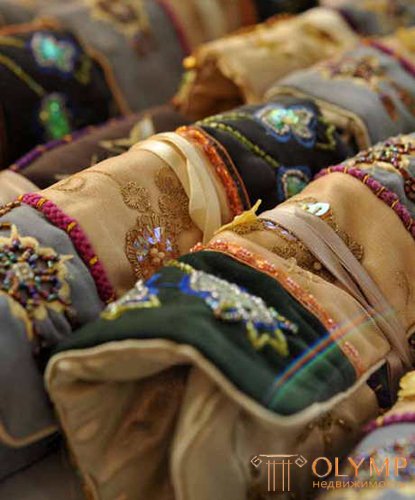
Moroccan style - originated in the era of colonial conquest. It is a mixture of European and North African traditions.
Morocco is a country of mixed, in one peculiar and independent, cultures and traditions. The influence on the Moroccan style in the interior was made by the traditions of Berbers, Mauritians, Phoenicians, Romans and Greeks, French, Spaniards and others. European countries ..
Today, the interior ideally combines sophisticated Moorish ornaments, European materials and furniture, a coarse nomad style. Such a mixture of eastern harmony and primitiveness of the Berbers creates a unique charm, a special flavor.
Moroccan style in interior design, in addition to architectural and spatial solutions, emphasizes the contrast of blue-turquoise colors and a range of terracotta (traditional colors of natural pigments of the city of Marakesh), as well as an abundance of oriental elements of interior decor: handmade carpets, brass jugs, flasks for water, furniture in oriental style, metal perforated lamps from Morocco.
Characteristic features - the finest wooden carving, stucco molding and mosaic of ceramic tiles, an abundance of carpets and other original textiles. The main focus is the widespread use of African ornaments.
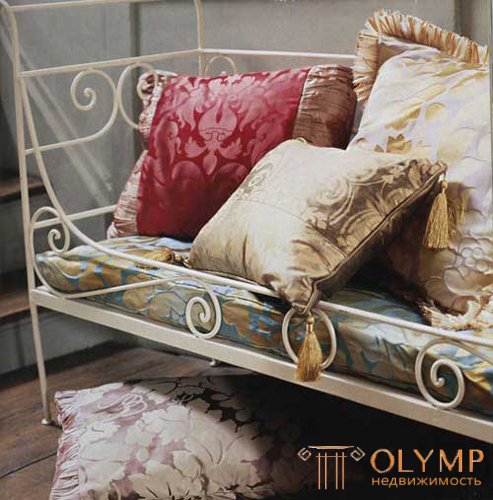
Moroccan style in the interior, photo
A large number of niches are used in rooms with candles, books, engravings. The furniture is mainly made from Tui or Lebanese cedar with inlay and mother of pearl. Moroccan style in interior design, emphasizes the abundance of handmade oriental carpets, a lot of pillows and rollers on the sofas, as well as the presence of: vases, hookahs, chests, brass jugs, lamps with stained glass inserts in the oriental style, ceramic dishes, jewelry boxes with ornaments, plenty of lamps with stained glass inserts
Color spectrum: white, red, blue and blue, green, terracotta.
Morocco is a country located in northwestern Africa. It is separated from Europe by 14 km. Strait of Gibraltar. This country is unique and distinctive, ranging from climatic features to cultural heritage. Moroccans say that you can go to four seasons in Morocco in one day. In the morning - swim in the Atlantic Ocean or the Mediterranean Sea, in the afternoon - go skiing in the Upper Atlas Mountains, and in the evening - to be in the Sahara. In order to understand where that came from in this style, we need to get back to the story a little.
The history of the region that makes up modern Morocco is formed by the interrelations of the indigenous population - the Berbers and various peoples who successfully invaded the country. For the first time, the Berbers are mentioned in the history of Africa as robbers, who subdued all the trade routes through the Sahara, and the first of the strangers were the Phoenicians, who founded trading cities on the Mediterranean coast (XII century BC). Later their colonies were captured and expanded by the Carthaginians. In the II. AD The Roman Empire conquered Carthage, which led to the rule of the Romans on the Mediterranean coast of Africa. The period of relative peace has begun. Berbers settled in cities on the coast and in the III. AD adopted Christianity.
The Byzantine rule was brought to an end by the Arabs who invaded Morocco in 682, spreading the power of Islam. Which significantly influenced the life of the Maghreb. Islam was an ideological and organizational binder, to ensure the caravan route from India to the Mediterranean countries along the Red Sea coast. He united the tribes and erased the differences between them. Based on the creation of a common cultural space, Islam and the artistic traditions of different nations have enriched each other, and some national genres and storylines, such as poetic, have acquired an all-Muslim meaning. Having absorbed the culture of the Persians, Syrians, Jews, and other peoples inhabiting the conquered lands, the Arab-Muslim culture became one.
At that time, Morocco became the center of the empire, which embraced modern Algeria, Tunisia, Libya and most of the territories of modern Spain and Portugal.
The collapse of the empire began in the XIII century. after the invasion of the Spaniards, and by the middle of the century riots and civil wars between the Berbers and Arabs swept the country.
The revival of Morocco began in the XVI-XVII centuries. and is considered a golden age for the country, mainly due to the development of trade, handicrafts, manufacturing and shipping, which favorably affected the development of art and architecture. At this time, the warring regions of the country began to unite.
The period of expansion to the coast of Morocco begins with the invasion of the Spaniards and Portuguese into the port of Ceuta in 1415.
North Africa, the closest to Europe part of the continent, attracted the attention of the colonial powers - France, Britain, Germany, Italy and Spain. As a result, at the end of the XIX century. the region is in colonial dependence.
European companies and settlers occupy the most fertile lands, establish control over banks, as well as over most industrial and large trading enterprises. Foreigners mine minerals, build railways and highways, develop communications and expand ports; build schools and lyceums, spreading European knowledge. At that time, the bulk of the population was peasants, and attempts to break free from the influence of European states were ineffective, and, moreover, African states were financially dependent on Europe. And yet, in the 50s – 60s of the 20th century, North African states gained independence.
A significant influence on the culture of Morocco in this period had France and Spain. France owned most of Morocco, and accordingly made the most significant contribution to the history of the state.
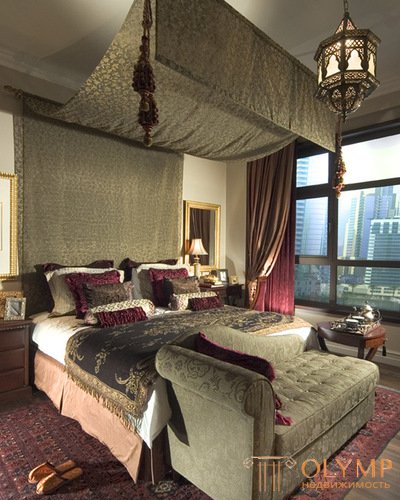
Moroccan style in the interior, photo
The first French governor, Marshal Luate, respected the cultural traditions of Morocco, he did not begin to destroy and rebuild the existing cities, but built new ones of the French type. The French did not impose their architectural canons. They left untouched old quarters in the center. Noisy bazaars, narrow streets, city houses with closed courtyards - traditional Arab "riads" have been preserved. In many houses, designed by French architects, you can see the Arabic ornament - mosaic, lined with tiles, wooden carving, friezes with complex stucco, wooden ceilings. The original masterpiece of architecture - the villa was built by artist Jacques Majorel, in the 20s of the last century. After his death, Pierre Berger and Yves Saint Laurent purchased the estate. After a long restoration - the house was revived, successfully combining Orientalism and modernism.
French architects and previously participated in the design of buildings for various purposes in the territory of modern Morocco.
One of the largest and most beautiful mosques in the world, the Hassan II Mosque, stands on the ocean shore in Casablanca. It is the westernmost and second largest mosque in the world after Mecca. Its architect, the Frenchman Michel Pinsot, was not even a Muslim.
A significant contribution to the popularization of the Moroccan style was made by impressionist artists, in particular, Henri Matisse.
So, what is a long intersection, mutual influence and interpenetration of different cultures could not affect the development of culture in the country, and as a result on the formation of the Moroccan style. Morocco is a synthesis of the incompatible, international, modern and unchanging - stretching back centuries.
Moroccan style can be divided into two directions: Berber and Hispano-Moorish (Andalusian).
Berber - simple and concise, a little rude in execution. It is strikingly different from the lush Hispano-Moorish. For thousands of years, the art of the Berbers has been preserved in its original, primitive form, where utilitarian tasks are the main ones. And no civilization, even the dominant - Muslim culture could not have a noticeable effect on him.
Today, the Moroccan style is relevant throughout the world, it can be found in the homes of famous people in Europe, in America or Australia. He firmly holds the leading position, is easily recognizable and is becoming very popular in Russia.
Moroccan interior design - bright, but not motley. Muted soothing colors are used - white walls, dark woodwork, black forged or dark wooden furniture, terracotta carpets. Against the background of such muted tones, mother-of-pearl, amber and brass inlays, fine mosaic of tiles look great.
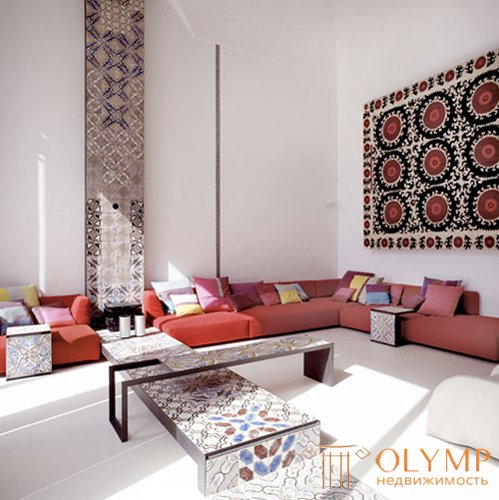
Moroccan style in the interior, photo
Moroccan style in the interior involves covering the tiled floors with colored camel wool rugs. Most often, the patterns of mosaic tiles, carpets and carved furniture panels have geometric patterns: six-pointed stars, flower heads, formed from geometric shapes. These ancient ornaments today adorn the walls, floors, stairs and fireplaces.
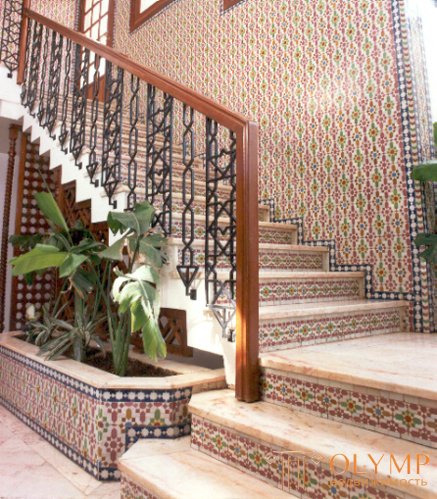
Moroccan style in the interior, photo
Wooden cabinets and tables have a rich brown or red color, or ivory. The doors of the cabinets are made carved, painted with Arabic ornaments.
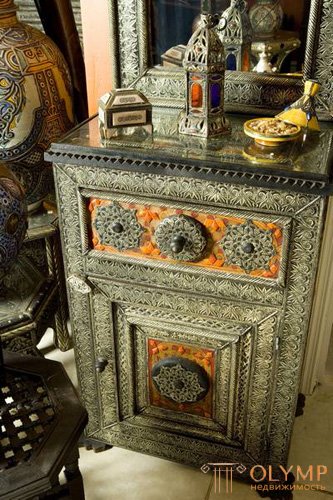
Moroccan style in the interior, photo
The abundance of pillows on sofas, armchairs and puffs covered with covers or decorated with fabric with African patterns or colored wool tassels at the corners. A more expensive treat is the upholstery of the sofas with camel leather.
A characteristic feature of the interior decoration in the Moroccan style is the decoration of dishes made by Berber women using the most primitive technologies. Vases, cups and plates are made without a potter's wheel. They are molded by hand, dried in the scorching sun or by the fire, after which they are polished with stone. Such dishes are placed in the niches of the walls, hung on the walls, and large vases are placed on the floor. To create more expensive vases, they are covered with leather, decorated with bone and brass. Carved wooden and chased copper plates and dishes that darken the edges, giving the effect of antiquity, are used to decorate the walls.
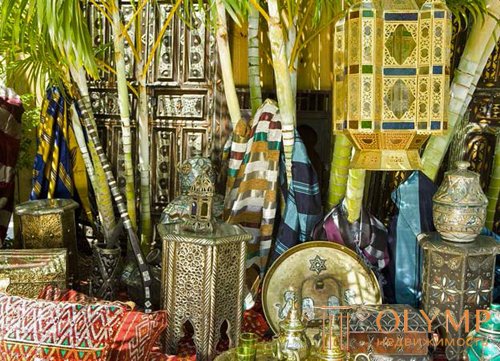
Moroccan style in the interior, photo
Moroccan style in the interior, thanks to a combination of several cultures, allows the imagination of designers and decorators to roam. Most often, the traditions of ancient peoples are mixed with the modern European interior. As a result, another “Moroccan” style is created, in which the ancient traditions and the bold artistic design of the author harmoniously intertwine.
In such houses, carpets woven according to Berber design sketches, cover orientally low and wide sofas, on which there are many bright cushions that are not typical of traditional Moroccan color interiors, for example, of a juicy red color. A chair from Corbusier in the style of constructivism peacefully gets on with the Tangier lamp made of wrought iron, set on the floor in the form of a vase.
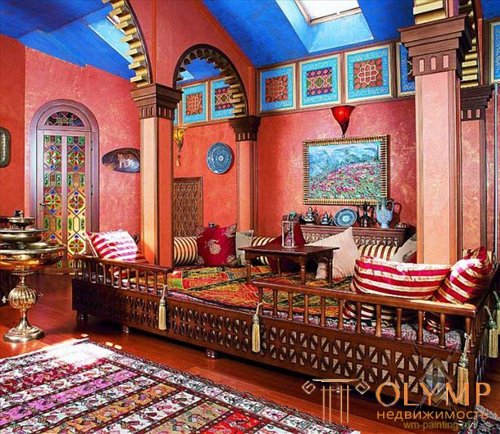
Moroccan style in the interior, photo
In the mansions of European celebrities in Tangier, a bright mosaic covering the bathroom walls, colorful stained glass doors, Japanese fabrics against the background of rich turquoise or pale lilac walls are combined with characteristic Moroccan forged lamps in the form of stars, wrought-iron furniture and woven carpets. Geometric ornaments, fashionable in Morocco since the 13th century, decorating ceramics and wood, are combined with comfortable European furniture and modern elements of furnishings.

Moroccan style in the interior, photo
Walls and ceiling. As a rule, it is a warm color of the walls, it is possible to use traditional Moroccan plaster “TADELAKT”. Thanks to her, the walls are similar to marble. Tadelakt is a glossy mineral plaster for water-resistant surfaces, for interior decoration according to traditional Moroccan technology from a mixture of sand, quicklime and earth pigments. Berbers in Morocco work very simple, but, nevertheless, effective tools. The most important of these is stone, and the longer it is used, the smoother and more valuable this coating becomes.
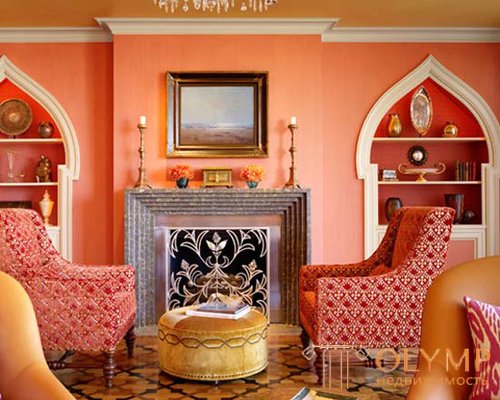
Moroccan style in the interior, photo
Decorating technique - painted surfaces of walls in contrast to the carved frieze on the top of the wall or with a decorative carved inset is very relevant in this style. Moreover, the tone and color solution can be both related and contrast. For example - white walls and white frieze, or blue walls and white decorative frieze.
The ceiling can be decorated in several ways depending on the purpose of the room, for example:

Moroccan style in the interior, photo
The floors. On the floors, Moroccans use the same “ZELLIJE” (“ZELIDGE”) technique as on the walls. Also relevant in this style - terracotta tiles and stone floors, their use is due to climate needs. In our climate, you can replace the tile - linoleum. But if there is a great desire to veneer the floor with ceramic tiles in residential premises - I recommend using “heated floors”.
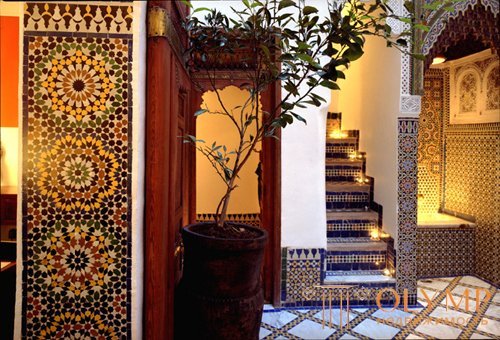
Moroccan style in the interior, photo
Textiles and accessories. A special theme in the Moroccan interior is ARTISANAT (from French - handicrafts). Moreover, the products can be of different quality and for different classes, both for ordinary people and for princes and kings. Carved furniture is very popular, the furniture is hand painted. Carved chests and frames for mirrors inlaid with mother of pearl, wood, camel bone or nickel silver. Lanterns of embossing with colored glass; Camel leather lamps on a metal frame. Carpets - made in a variety of weaving techniques; ceramics; leather poufs and more.

Moroccan style in the interior, photo
Textiles are one of the main components of the Moroccan style. The abundant layering of fabrics, embroidered pillows and carpets should create an atmosphere of peace and harmony.
And of course, for piquancy (if the architecture of the building and premises allows it) add to the interior a fountain and window shutters made of dark carved wood or forged lattices.
Moroccan style is one of the most exotic mixes of several cultural layers - Moorish, Arabic, Berber. And European. The Romans, the Spaniards, the British - they all left traces of their culture here, but the influence of the French was the strongest. It is thanks to the French architects and designers that this very concept exists today - Moroccan style. However, this is by no means expressed in the imposition of European architectural canons, it is an organic synthesis of European and North African elements.
Moroccan style suggests an unexpected variety of design: from naive to sophisticated. The use of this style would be equally appropriate in a luxurious mansion and a simple home. The main requirement for creating an interior in this style should be improvisation and a bold use of the material.
If you want to create coziness and bring sophisticated exotics into the interiors of your house (and not only) try using Moroccan style and you will not be disappointed.
Что бы оставить комментарий войдите
Комментарии (0)